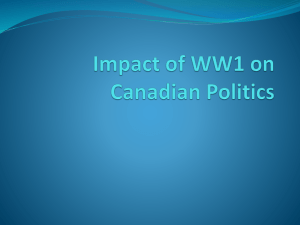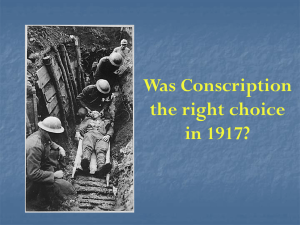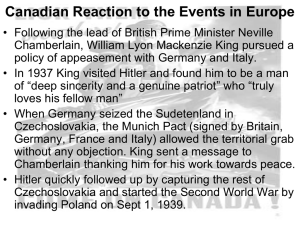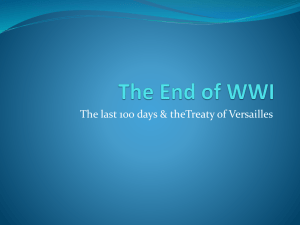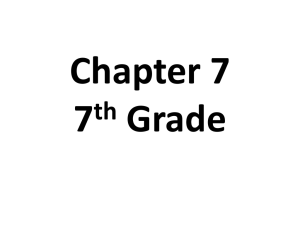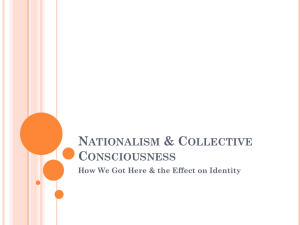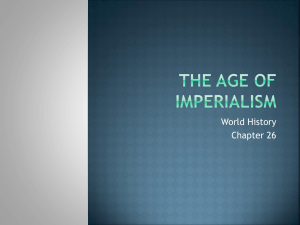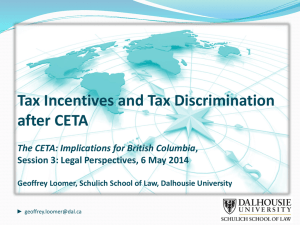Canada and World War One
advertisement
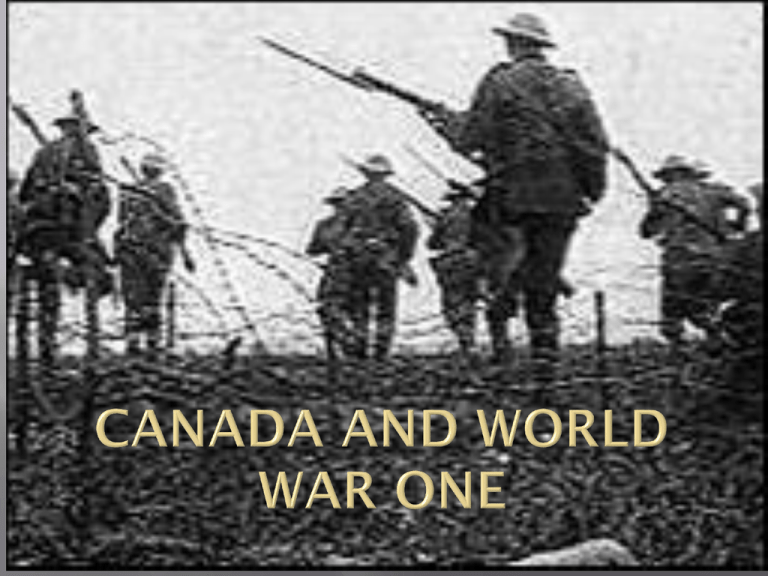
The Great War – left a huge mark on an entire generation of people -14 million dead/21 million crippled World War One is considered by many historians to be the single most significant event of the 20th century Over a period of many years prior to the outbreak of war many old and new European powers had competed in an “arms race” and a race to gain imperial possession around the world. This nationalistic “saber- rattling” led to a complex network of military alliances and had turned Europe into a powder keg. The spark that set off the war was the assassination of the heir to the throne of the Austrian-Hungarian Empire (Archduke Francis Ferdinand) by a Bosnian nationalist (Gavril Princip) in the Bosnian capital of Sarajevo. As aggression begins over the Balkans the “alliances” cause all Europe to be drawn into war. Triple Entente Great Britain France Russia Triple Alliance Germany Austria- Hungary Italy The first major action of the war sees Germany sweep through the “backdoor” of Belgium as part of the “Schlieffen Plan” .This plan involves the Germany army flanking the French forces and coming within 25 miles of Paris before being pushed back and both forces being forced into a stalemate in northern France. When the war begins on August 4/1914 Canada’s foreign policy is still controlled by Britain which meant that Canada is automatically at war because of being a member of the British Empire. Robert Borden is P.M. Wilfred Laurier also supports the war effort. Most Canadians are enthusiastic to go off and “fight the Hun”. The war is supposed to be short- “I’ll be home by Christmas”. The economy has slowed down significantly and unemployment is high. Young men are eager to enlist and Canada’s military grows from 3,000 to 30,000 in months. Troops are trained at Valcartier under the Minister of the Militia Sam Hughes. A poorly trained and equipped Canadian Expeditionary Force leaves for Europe by October and is in France by December. Ottawa passes the “War Measures Act” and receives sweeping powers to support the war effort. Canadian industry is transformed to produce armaments. At the beginning of the war manufacturing sector is run haphazardly with the result being poor quality and high production costs – “profiteering” is a concern. Canadian wheat production is seen as a key to the war effort because the Ukraine is now a battlefield. Propaganda is important in supporting the war effort Women enter the work force in the factories and fields War bonds are sold to finance the war “Subversives” are arrested – Germans, Turks, Austrians Ukrainians are interned and property seized Government expenditures rise sharply due to war Income tax is introduced- “a temporary measure” The Great War saw the Canadian Government under Robert Borden have to deal with many issues that involved the war effort. The Canadian Government’s mobilization campaign under Sam Hughes had not achieved the goal of training and equipping our soldiers properly, but the issue of profiteering had to be dealt with quickly and dramatically by Joseph Flavelle. The labeling of 80,000 so-called “enemy aliens” who were “disenfranchised” was a controversial step but the internment of 8,500 (5,000 Ukrainian immigrants) from 1914-20 was an issue that haunts us today. The Women’s Movement took great strides forward during the war as women assume the role of men in the workforce and participated for the first time in the military. In 1916 many provinces enfranchised women and in 1918 women received the right to vote federally and were also successful in the outlawing of alcohol sales or prohibition. By 1916 the patriotic enthusiasm had disappeared and it became apparent that the need for new recruits was increasing as the war took its toll on Canadian soldiers and the death tolls rose sharply. In 1914 Robert Borden had promised not the conscript troops, but after returning from Britain in 1916 Borden had seen the need and told Canadians that he would have to break his promise. In May of 1917 Borden rises in the House and announces “The battle for Canadian liberty and autonomy is being fought today on the plains of France and Belgium.” Borden had promised to send 500,000 troops (Canada population- 8 million and 1.5 million men are military age). Britain, New Zealand and the U.S. had conscription. Conscription is angrily rejected by Quebec and riots break out in Montreal. Bourassa had warned many years early that the “imperialist” would drag Canada into a war and in the process “bankrupt” Canadian industrial and agricultural production. Quebecers feel no ties to Europe and the Canadian military is an English speaking entity. (except for the 22nd battalion the Vandoos). Other groups opposed conscription including farmers, and labour unionists (Ginger Goodwin story). Many feel that they are doing their part for the war by and can not afford to give up their workers. The Liberal party was split along linguistic lines with Laurier on the anti-conscription side. Borden decides he must call an election over the “Military Service Act” (conscription) Borden has no intention of losing this election and he quickly introduces the “Military Voters Act” which allows all soldiers a vote regardless of ethnic background. He also introduces the “Wartime Elections Act” which allows women related to servicemen to vote and disallows conscientious objectors and recent immigrants the right to vote. Borden also invites the pro-conscription members of the Liberal party to join in a “Union Government” to support the war effort. The results of the “khaki” election were heavily in favor of the Union Government (152-82 seats) Riots breakout in Quebec when military “exemptions” are denied (four die in the riots when soldiers are forced to shoot into an angry crowd). Canada meets its goal with recruitment. Of the 100,000 that were conscripted 24,000 end up serving in Europe but the hatred of Quebec for the “Prussians next door” will not soon be forgotten. As Canada enters the war our troops were not well trained or equipped but as the war progresses they learn quickly from their experiences. As the war begins Canadian troops are under the command of British Generals and this is an issue until later in the war when Canadian commanders are disturbed by the “attrition” approach to the war that comes from trench warfare. Canada will prove itself on the battlefields of Europe. Ypres- 1915- Canadian troops saw there first real battle as French troops fled Canadian troops filled the gap and were subjected to the war’s first gas attack, but the troops held their ground despite incredible odds. Somme-1916- A daylight offensive attack by British commanders that lasted three months and gained little – (500,000 allied troops lost and 24,000 Canadians including the annihilation of a Newfoundland regiment) Sir Julian Byng leads a fierce attack that proves Canadian troops are ”battle-hardened”. Andrew McNaughton pinpoints German artillery and our troops follow a “rolling barrage”. All four Canadian divisions sweep the ridge. “The most perfectly organized victory of the war” – “A nation making moment” that gives the troops great pride. Arthur Currie is knighted and given command of Canadian Corps 3,600 Canadians die in this battle Canadian troops are order to attack despite fierce opposition and a high estimated cost of lives by the British Command. Currie’s carefully planned attack succeeds. -16,000 troops lost 5 km of muddy craters gained and later lost After a final push by the Germans to win the war Canada spearheads an ally counter-attack at Amiens- crushing German lines and capturing 13km in one day (5000 POW’s) -Arthur Currie shifted attack to the Hindenburg Line -4 divisions of Canadians defeated 47 German divisions due to a German army that is badly supported and undersupplied. Canadian troops liberated 200 cities and capture 30,000 POW’s -On Nov. 11, 1918 at the 11th hour – The “Great War” ends with an armistice At the beginning of the war the airplane was only 11 years old. Canada had an unpaid commander and an assistant and one planepurchased from the U.S. for $5000. Ten thousand Canadians join the R.A.F. and eventually make-up close to 30% of that force. The novelty of the plane in 1914 becomes a military necessity as the war progress enabling reconnaissance of troops and artillery, bombing of railways and industrial targets behind enemy lines, attacks on U-boats at sea and aerial attacks on Zeppelins. Airmen become the “new warrior hero” as the war goes on. 25,000 Canadians serve in the British Air Service with flying aces Billy Bishop (72 kills) and William Barker considered to be 2 of the top 5 airmen of the air service. Roy Brown was given credit for shooting down the “Red Baron”. The Canadian Navy in 1914 consists of 2 ships and 350 men. In WWI the Canadian Navy took on the responsibility of protecting Canadian ports and outgoing convoys that were vital to supplying Britain. Canada’s navy will grow to 100 war vessels, 2 submarines and 5,500 men. As with the air force many Canadians served in the Royal Navy. Although 150,000 troops were under Arthur Currie’s command on the Western front at the end of the war in 1918, 40,000 were also serving under other commanders (Royal Air Force, Royal Navy). With specialized skills as fallers and railway builders Canadians found themselves all over the world in places like Gallipoli and Palestine fighting the Turks, in the Mediterranean as hospital units, as engineers operating barges on the Tigris and Euphrates Rivers and in the United States training troops after the US joins the war in 1917. Canadians were also sent to fight in support of the Communist troops in northern Russia and on the Caspian Sea to protect the oil fields from the Turks. Canada’s coming of age had not happened without a huge cost. The War bought many changes to Canada. Canada had proven itself on the battlefields of Europe where 620,000 Canadians had served in the war with 60,000 died and 172,000 wounded (many for life), a very heavy contribution of troops in relation to our small population. The battle scars will remain for many years to come. Canada had proven it could be an industrialized nation in supporting the war effort. Many companies had made huge profits during war and there was resentment over possible profiteering. Unions were growing stronger. Post war Canada had thousands of returning troops to re-establish into Canadian society. Government needed to step in to support veterans and their families as factories closed, unemployment and inflation rose and workers demanded higher wages (no increases during war). Government was going to play a bigger role in the lives of Canadians (business, finance and social services) as a result of the war. Canada now has many new domestic issues to deal with like the Spanish Flu that kills between 30,000 and 50,000. Women were now to play a more active role in politics. French Canada and English Canada were deeply divided over the Canadian war effort and conscription. On an international level Canada had distinguished itself as an independent nation. In 1917, the Dominions join the Imperial War Cabinet and Resolution IX gave the Dominions full recognition as “autonomous nations of an Imperial commonwealth”. Borden insisted on Canada signing Treaty of Versailles as a member of the League of Nations. Canada breaks many of its ties with Britain and will now take responsibility for its own foreign affairs. Canada will also now enter into a relationship with the United States that will dominate her foreign policy during the twentieth century.


